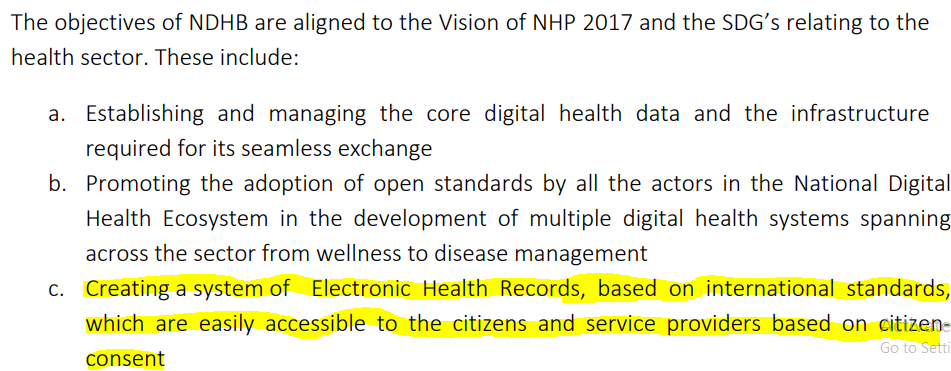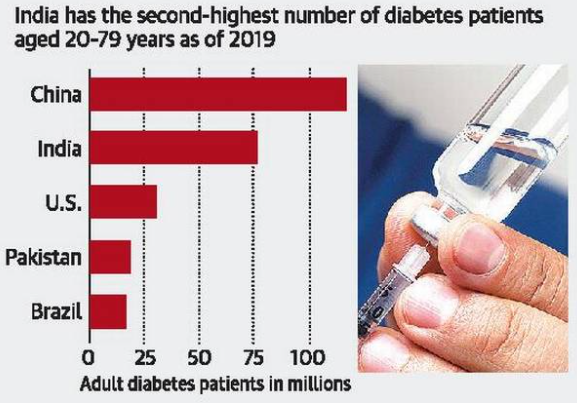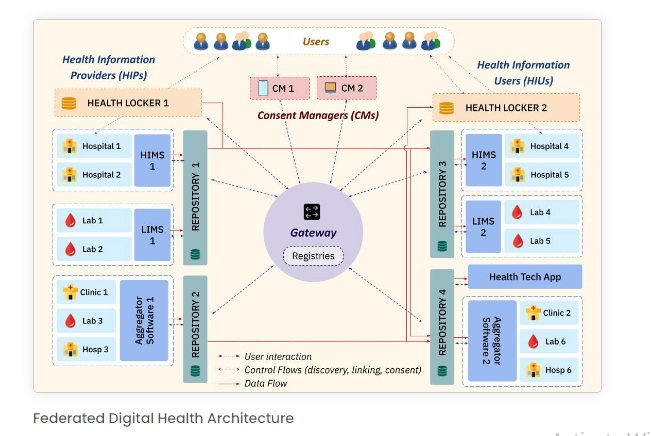Bringing Healthcare Interoperability To India – Chronic Care
Introduction (fetch patient’s data):
This is a article about bringing data digitization specially interoperability in India. Every human discovery has proved to solve some major problem faced by the society throughout the history. The early man’s discovery of fire was used to solve the problem of bringing light in darkness and it also solved the problem of cooking raw meat.
Now healthcare data digitization should focus on solving some major health problems in country. Technology should understand what is happening to the patient. Meaning the technology should be capable to fetch medical history and details (data) from the patient and perform some activity on top of it. Technology (healthcare data digitization & interoperability) shouldn’t be just a medium of data flow from one hospital to another or to insurance companies other words – it shouldn’t just commodify the patient/physician relation. It must solve the problem of disease reduction in country as well.
This is one of the core principle adopted by NDHB (National Digital Health Blueprint) (i.e) to make electronic health record that is accessible to the patients. This will be a vital way to fetch the patient’s data. NDHB also provides guidance on how to implement a Digital Health Eco-System in our country.

Question is, how feasible / practical it is to use NDHB’s principle to solve the chronic sickness in our country?. Why chronic sickness?, because 1 out of 6 people have diabetes (best example of chronic sickness) in our country. If there is some problem that we need to fix immediately then it must be solving the diabetic problem. Let us take this as a case-study of how NDHM can solve diabetes. But to fix a problem we need to know the problem. Let us first know the problem here in brief.
What causes diabetes?
Abnormal level of sugar (glucose) in the blood causes diabetes. Our pancreas secretes insulin which lowers the blood sugar level. If the body is not able to use this insulin properly to reduce the sugar level that results in diabetes. Sometimes this insulin production is not sufficient or not secreted properly then that will also contribute a person to be diabetic.
The elevated level of blood glucose a.k.a Hyperglycemia is the most problematic disease that India is fighting now. As per this article published in The Hindu Magazine India is now home to more than 75 Million Diabetes patients. Which means one in 6 people of India has Diabetes. This makes India as a second largest country to hold Diabetes, the first one eventually being China. This is an interesting fact. population is directly proportional to Diabetes.

Statistically Indian’s are dying more by over eating. How NDHM & NDHB principles can solve or address the diabetes problem?. Let us look at the federated digital health architecture proposed by the NDHM

We need to keep in mind what we are bringing up as “an idea of change”. Bringing a disruption in existing healthcare eco-system is always useful but it should not open any back-doors too. Let us not forget that Thomas Alva Edison not only discovered light bulb but to prove AC is dangerous he demonstrated electric chairs. A simple flaw can be a historic mistake.
A twin problem in Indian healthcare:
Objective is not to treat patients as customers. At the same time, there is a mindset for the people with respect to doctor visits & many people have pride in saying “I never visited hospital in last one year or six months”. Most people in India are self-doctors treating themselves and prefer to trust pharmacy guy more than doctors. This is not a healthy sign for our country. Medication is never a mandatory thing. But doctor visit is a must.
Why?, Because many people die without even knowing what was their health problem. This is very evident in the case of diabetes. As per diabetes atlas of south east asia1 in 2 people with diabetes remain un-diagnosed and are at a higher risk of developing harmful and costly complications. If you’re reading this article ask yourself, when was the last time you did a full body checkup?.
If the patient is reluctant to meet the doctor or hesitant to do proper checkup then how do you expect to fetch the data?. If there is no data from the patient how can we remind him to do the next checkup?, how can we do analysis on what he needs further?. How can technology help him recover from sickness or solve disease?
Another big problem is how do we get proper (true data) data set from a patient?. Patient’s lie every time they come to doctors. For example: a heavy drinker will come to doctor and say he is a social drinker. Another typical example women taking medication from Ayurveda for the period problem (PCOD problems) for quite sometime will never tell the English medicine doctor that they took Ayurvedha medicine.
Now this gives two problems to Indian Healthcare Data. In fact this is a twin problem we need to deal with
1) How to get data from patients if patients don’t visit the doctors or do body checkup?
2) Physicians will prescribe wrong medication/diagnosis if the patient is not 100% truth with his body conditions.
How can Indian Healthcare Digitization Solve this?
Patient’s not visiting the doctors is one big problem in India. we need to face this while bringing healthcare interoperability to a developing country like India. Indian Healthcare Digitization (IHD) needs to change its structure.
1. We need to smooth patient’s visit to the doctor.
2. IHD also should make periodical physical checkup as a mandate.
3. IHD should focus on organizing patient’s data and make it accessible across the country.
The point one is very straight forward. I’ve blogged about this earlier as well in this blog. We need to increment the number of physicians to patient’s ratio. Currently there is only one doctor for 1,457 people which is very lower than the WHO proposed norm of 1:1000.
If the above three things are achieved in Indian Healthcare Digitization then India will be 1st country to bring down the numbers of diabetes over a period of 5 years from now. If a telemedicine product is not satisfying the above three rules the the product must not be sanctioned by the medical association / government. Health of citizen should be a government care, it can never be a private business.
For the 3rd point I believe there needs be law passed by the Indian govt. India has a strange habit of marrying people over 3rd party application called matrimony. No other continents have this habit. Only the Asian search their girls and boys in matrimony and decide to live with strangers. So, often times I see man or women marrying the other who has undiagnosed chronic sickness leaving their future in jeopardy. So, a PHR (personal health record) ID should be given to each and every citizen. In the matrimony profile the PHR id needs to be integrated as well, with the consent of the person anyone can check the health issues of the person.
Why Chronic Illness (specially diabetes) is a threat?
One of the major villain of many Indian families is the diabetes. This disease is not created by the Nicotin, liquor or drugs, instead they are created by improper lifestyle. Diabetes is well defined by the physicians as life-style disorder. Doctors insist a proper health checkup for every 3 three months for a confirmed diabetes patient. Doctors insist diabetes check-up for individuals after reaching 30 years. But there are also cases of high diabetes patient even before 30 years. There are cases where patients are more than 60 years of age and are not diabetic at all.
Historically this era should be termed as “good human era”. Once people died without proper food. Now people are dying by eating more (including corona covid-19). This is definitely a good sign. Because we have more probability to kill ourselves than getting killed by bomb blast (statistically – Suicide is more too). We don’t have big war. Certainly we are not seeing war where people are killing one other very roughly. For example Brexit is one of non-violent independence fight of Britain exiting European union (they might join back looks like). 50 years back this would have turned out to be another world war.
So, we don’t have war, we have food, we have money & still people die because of diseases. Healthcare data digitization & interoperability should be a driving tool to solve this. We need to fight a big war against diseases now. India vs. disease in particular. While reading this article just think about how many family members or relatives you have lost due to diabetes (I’m sure the number of people who lost their lives due to diabetes will be alarming). We need to take chronic illness like diabetes into consideration here because indirectly diabetes causes multiple other diseases.
Humans never take a close look at what’s happening to them until something malfunctions in his/her body. A human always expects a signal or warning to come from his body to meet a doctor. Sometimes this warning happens earlier and results in early meeting with physicians but in most cases people take these warnings very lightly and meet the physicians very late by that time the chronic illness would have got severe. It is must that citizens of our country to visit the physician or take full body check up periodically.
If a country is down economically, it is always advised that the customers of the country needs to be encouraged to buy products (materials). Because people who sell the products (be it small or large) are the one who build the economy of the country. As the materials sell a lot, the more profit a company gets and it in turns reflects on the boost in economy of the country too. With respect to healthcare, India has not done this consistently over 60 years of time.
Diabetes scary stats:
The Diabetes Atlas of the south east Asia provides an very interesting list of features. The following figure applies for entire of south-east Asia.
- 1 in 11 adults have diabetes
- 1 in 5 of the people with diabetic in the world comes from south-east Asia.
- 1 in 6 adults with diabetes comes from India
- 1 in 2 people with diabetes remain un-diagnosed and are at a higher risk of developing harmful and costly complications.
- 1.2 million deaths are attributable to diabetes – the second highest number of deaths of all IDF Regions.
- 1 in 4 live births are affected by hyperglycemia (blood sugar) in pregnancy.
- The total diabetes-related health expenditure in the region was USD 8.1 billion – the second lowest regional diabetes-related health expenditure.
The above statistics looks pretty scary. You can refer the stats of other regions and how much impact diabetes is causing on the other parts of the world from IDF Diabetes Atlas, 9th edn. Brussels. When you are reading this blog question yourself, When did you last did health checkup?. When did you check you blood glucose level recently?
What causing India to have more diabetes is still a question that doctors are finding an answer for. Its a struggle for the Indian Healthcare sector to identify the root cause of this problem. The doctors are pretty sure in confirming that Diabetes is only because of poor lifestyle. improper food habits, improper physical activity etc.
If so there are a lot of cases reported across the world where people with regular physical activities, proper diet management, without any obesity still be diabetic by 30 years of age. Why is that happening? is a big question that is bothering the Indian physicians.
Diagnosis Issues:
50% of people in India are not really worried about being an diabetic patient. They do not know the consequences of getting their leg hurt. They do not appreciate the value of doing physical activity. The best word to put is, people are ignorant. They need to be encouraged to take proper check-up for diabetes. As a part of #GreatIndia2Months plan it would be good if the people who see this blog post trend this hashtag in the social media just to create awareness on the ever growing diabetic problem.
Confusion On People Mass:
There is a lot of confusion that is deliberately seen on the people of India when it comes to diabetes disease. Confusion on taking pills or going for no pills, taking vegetarian food, non-vegetarian food, Going to Siddha medication, Unani or Allopathy or not taking any medication?, these confusions are making this disease win over the lives of people.
Government funded collaboration needs to happen for better medical facilities an R&D needs to be established for multiple medicine practices and identify the best out of them. Else research needs to be conducted properly in such a way the government should satisfy which is best medicine to practice and which is not to the people.
I must show my appreciation for your kindness for people who must have assistance with in this subject matter. Your very own dedication to getting the solution up and down became extremely significant and have regularly made others just like me to attain their dreams. The valuable facts entails much a person like me and much more to my office workers. Many thanks; from all of us. Arlena Orrin Aubarta
I was extremely pleased to find this site. I wanted to thank you for ones time for this wonderful read!! I definitely appreciated every part of it and i also have you saved to fav to check out new stuff in your website. Joelly Edik Kiri